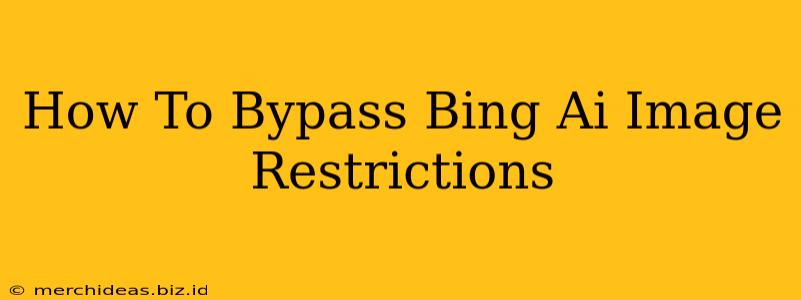Bing AI's image generation capabilities are impressive, but sometimes its restrictions can be frustrating. Whether it's due to safety guidelines, content policies, or simply limitations in the model, you might find yourself wanting to create images that Bing AI won't generate directly. This guide explores methods to overcome these limitations and achieve your desired image outcomes.
Understanding Bing AI's Image Restrictions
Before diving into bypass techniques, it's crucial to understand why Bing AI might refuse a prompt. Its restrictions are primarily in place to prevent the generation of:
- Harmful or offensive content: This includes violence, hate speech, nudity, and other explicit material.
- Illegal or unethical content: Anything that promotes illegal activities or infringes on copyright is forbidden.
- Politically sensitive content: Images that could be interpreted as biased or promote specific political agendas are often blocked.
- Low-quality or incoherent prompts: Vague or poorly written prompts may fail to generate any image at all.
Methods to Bypass Restrictions (Ethically and Responsibly)
It's important to preface this section by stressing the importance of ethical and responsible image generation. While these techniques can help overcome limitations, they shouldn't be used to circumvent safety protocols or generate harmful content.
1. Rephrasing Your Prompt
Often, the simplest solution is to rephrase your prompt. Try these strategies:
- Use different keywords: Instead of "a violent fight," try "a dramatic clash." Instead of "a naked person," try "a figure draped in cloth." Subtle changes can make a big difference.
- Add descriptive details: More detail helps Bing AI understand your vision better and reduces ambiguity, thus minimizing the chances of triggering restrictions. For example, instead of "a scary monster," try "a towering, shadowy monster with glowing red eyes and sharp claws."
- Break down complex prompts: For very complicated scenes, break them into smaller, more manageable prompts, generating parts of the image separately and then combining them using photo editing software.
2. Utilizing Negative Prompts
Many AI image generators, including some versions of Bing AI, allow you to use negative prompts. These specify what not to include in the generated image. This can be effective in guiding the AI away from potentially restricted topics. For example, if you want a fantasy scene but are concerned about it being flagged as violent, you could include a negative prompt like "violence, blood, gore".
3. Using Different AI Image Generators
If you consistently encounter restrictions with Bing AI, consider exploring other AI image generators. Different platforms have different strengths, weaknesses, and content policies. Some might be more lenient or have different interpretations of potentially problematic content. Experimenting with different tools is a viable strategy for broader creative exploration.
4. Post-Processing with Editing Software
Once you have a base image from Bing AI (even if it's not exactly what you envisioned), you can use photo editing software like Photoshop or GIMP to further refine it and achieve your desired outcome. This allows for greater control and the ability to add or modify elements post-generation.
Conclusion: Responsible AI Image Generation
Bypassing Bing AI's restrictions can be a valuable tool for artists and creators, but it must be approached responsibly and ethically. Remember that the restrictions are in place for a reason, and deliberately trying to generate harmful content is unacceptable. By using the techniques described above responsibly, you can unlock the full potential of Bing AI's image generation capabilities while adhering to ethical guidelines and best practices.
